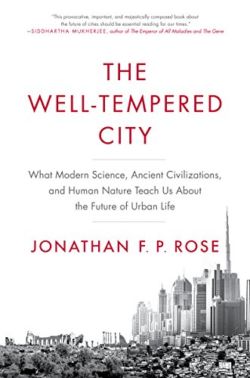Compassion and Cities
The religions and philosophies that emerged from the Axial Age were far better adapted to the increasingly sophisticated urbanism of their times. We need a new axial age today.
By Jonathan F. P. RoseThe following is an adaptation from Jonathan F. P. Rose’s new book The Well-Tempered City: What Modern Science, Ancient Civilizations, and Human Nature Teach Us About the Future of Urban Life. Please join us for a conversation with Jonathan F. P. Rose and journalist Andrew Revkin at the Garrison Institute on October 17, 7PM.
The world’s first cities were founded around temples approximately 3200 B.C. Cities were centers of power, cauldrons of opportunity, generators of knowledge, and fonts of civilization. And as the centuries passed, and new technologies were developed, civilization became increasingly materialistic and aggressive.
In response to what seemed like endless wars, a new world view emerged during the remarkable period between 800 and 200 B.C.E., a time that the German philosopher Karl Jasper named the Axial Age. During this epoch Confucianism and Taoism arose in China; Hinduism, Jainism, and Buddhism in India; Judaism and Zorastorism in the Middle East; and Pythagoras, Heraclitus, Parmenides, and Anaxagoras developed philosophical rationalism in Greece. This was the time that the foundational writings of many of the world’s religions were written—the canonical Hebrew texts that became the Hebrew Bible, the Analects of Confucius, the Tao de Ching, the Bhagavad Gita, and the Sutras of the Buddha.
Thinkers of the Axial Age came from a wide range of cultures and geographies, but they shared a common search for meaning. As they explored the nature of wisdom and compassion and the human mind, they asked, how does the individual relate to the whole? What is ethical behavior? And how does ethics permeate society?
These questions arose in response to an increase in violence and materialism resulting from two technologies that had swept across Eurasia. The first was the chariot-riding archer, who led to the rise of large, highly mobile armies around 1700 B.C.E. Five hundred years later the Iron Age produced even more powerful and destructive weapons. Emperors, greedy for land and power, began a thousand years of continuous war. At the same time the invention and widespread usage of coins to represent value dramatically increased commerce, accelerating the rapid growth of wealth, materialism, and inequality.
The consequence of these two technologies was an increase in aggression and suffering. In response, the sages of the age sought to find a new balance. By turning inward they advanced methods of deep contemplation. From this inner state they developed new systems of thought that promoted discipline, compassion for others, and the search to understand the larger whole.
 The religions and philosophies that emerged from the Axial Age were far better adapted to the increasingly sophisticated urbanism of their times. They gave rise to moral codes that allowed for a much more complex society to function. They enhanced systems of trust, essential for people to live closely together and to trade. They advanced compassion, a key element of a more equitable society. And they developed the idea of transcendence, the capacity of an individual to experience the ultimate nature of the universe. Transcendence obviated the need for an emperor appointed by heaven to serve as translator of the ways of nature, and arbiter of wisdom and justice. These new worldviews spread along the great trade routes, watering the soil of cities.
The religions and philosophies that emerged from the Axial Age were far better adapted to the increasingly sophisticated urbanism of their times. They gave rise to moral codes that allowed for a much more complex society to function. They enhanced systems of trust, essential for people to live closely together and to trade. They advanced compassion, a key element of a more equitable society. And they developed the idea of transcendence, the capacity of an individual to experience the ultimate nature of the universe. Transcendence obviated the need for an emperor appointed by heaven to serve as translator of the ways of nature, and arbiter of wisdom and justice. These new worldviews spread along the great trade routes, watering the soil of cities.
We are now living in a time of enormous complexity, rapidly spreading technologies and the acceleration of climate change, natural resource consumption, materialism and inequality. We need a new axial age, one that draws from the past, but grows from our current circumstances, grounded in great compassion, the desire to relieve the suffering of all beings.
Compassion harmonizes humans and nature in a framework that gives meaning to human activities. At the physical level this harmony increases the resilience of cities by integrating urban technology and nature. At the operational level it increases the resilience of cities by enhancing its adaptive capacity, so that it can evolve in dynamic balance with mega-trends, focused on its core objective: the well-being of both human and natural systems. At the social level, a compassionate temperament provides common values and meaning, key elements of altruism and cultural resilience. And at the spiritual level, it enhances a city’s sense of common purpose, giving rise to an integrated view of wholeness that generates resilience, healing, and the deepest well-being. Compassion provides the will to imagine and create a better future for all.
We live in a competitive, aggressive world. Every successful city must have protective systems to secure itself from others. Political and economic power are preconditions for a thriving city. And since cities do not exist in a vacuum, they must be part of strong countries that provide them, among other things, with defense, the rule of law, patent protection, transparent, corruption free governance, and the preservation of individual and collective rights. But while protection is necessary, it is not sufficient. Cities must also grow their capacity for compassion. Interweaving protection and compassion, cities can replace the concept of “stronger” with “better able to adapt.”

Altruism as a Protective Factor
When exposed to the same disease, why do some get sick and others do not? People have a range of protective factors. When individuals, families, and communities are exposed to stressors or risks, protective factors are conditions or attributes that enhance the likelihood of positive outcomes and reduce vulnerability.
Protective factors can be found in our DNA. Some people, for example, are born less susceptible to alcoholism than others. Protective factors can be enhanced by inoculations, such as vaccines for measles and mumps. Positive cognitive ecologies are protective, providing the stable base that helps children deal with stress. And altruism, the selfless concern for the well-being of others, is a protective factor. Individuals who are altruistic are happier, more flexible, and less likely to become sick. Altruistic neighborhoods have stronger social networks and are more resilient in the face of stress. Cities infused with altruism are more trusting, inclusive, and tolerant, have stronger, more diverse volunteer networks, are better able to plan for their future, and can take the necessary steps to carry out those plans effectively. Altruism infuses individuals with a sense of purpose that is greater than themselves. When collective altruism gathers a population around a common purpose, it moves the city toward harmony.
Wolf Singer, director of the Max Plank Institute for Brain Research in Frankfurt, observed that the healthy brain coordinates its different functions not by central control, but by what he calls “binding by synchrony,” in which the various systems of the mind share a common wavelength, and send coordinating messages on its pulses, forever talking and listening to one another. Goodness, beauty, truth, dignity, and compassion all share the cognitive signature of neurological coherence, bounded by synchrony. When the mind is pervaded by these qualities; we feel deeper, more alive, and more whole.[i]
Healthy cities are also bounded by a synchrony in which individuals, organizations, neighborhood groups, companies, and city agencies continually perceive their larger environment and independently adapt to it, making adjustments, improving their performance in a distributed but coherent way. And when they are bounded by the synchrony of goodness, beauty, truth, dignity, and compassion, they too become whole.
In the aftermath of the astounding suffering caused by Rwanda’s uncivil war, aid workers noted that the most traumatized people in refugee camps displayed remarkably different capacities to recover from the unspeakable events they had endured. Those who had a deeply held cosmology that they believed could explain the events they experienced were much more likely to rebound than those who didn’t. It was as if the traumas were sharp shards embedded in their minds, and their cosmology helped them assemble the shards into a smooth whole, like pieces of a jigsaw puzzle. Having a cosmology is a protective factor.
Bach wrote music to make such a wholeness. Christopher Alexander, the architectural theorist, wrote, “Making wholeness heals the healer. . . . A Humane Architecture does not only have the power to heal us. The very act of making it is itself a healing act for all of us.”[ii] And so, making a well-tempered city that reflects a larger harmony not only increases its resilience, but also our own.
Jonathan F. P. Rose works with cities and not-for-profits to plan and build green affordable and mixed-income housing and cultural, health, and educational centers. He is cofounder of the Garrison Institute and the creator of its Climate, Mind, and Behavior program.
[i] Jean Pierre P. Changeaux, Antonio Demasio, and Wolf Singer, eds., The Neurobiology of Human Values (Berlin and Heidelberg: Springer-Verlag, 2005).
[ii] Christopher Alexander, The Nature of Order, 4 vols. (Berkeley, CA: Center for Environmental Structure), bk. 4, pp. 262–70.
Photos: Courtesy of unsplash.com
